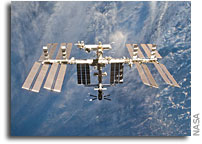International Space Station: Lead Increment Scientist’s Highlights For the Week of March 12, 2012

(Highlights: Week of March 12, 2012) — Ground teams continue to check out systems for Robonaut 2. Robonaut not only looks like a human, but it also is designed to work like one. With human-like hands and arms, Robonaut is able to use the same tools station crew members use. In the future, the greatest benefits of humanoid robots in space may be as assistants for astronauts during spacewalks.
Flame tests are nearly complete for the Structure and Liftoff In Combustion Experiment (SLICE). To date, more than 100 ignitions have been completed with over 3,000 photographs of 600 flame conditions. Most of the remaining tests will be for smoke point determination. SLICE investigates the nature of flames in microgravity. The results from these investigations could lead to improvements in technologies which aim to reduce pollution emissions and improve burning efficiency for a wide variety of industries.
Don Pettit made successful contact with Liberty Junior High School in Burbank, Ill., as part of the International Space Station HAM Radio experiment (ISS HAM Radio). By utilizing ham radios, this experiment gets students interested in space exploration by allowing them to talk directly with the crews living and working aboard the space station. Over 800 students and parents were present for the event.
Crew members completed sessions with Treadmill Kinematics. This investigation is the first to quantify the biomechanics of treadmill exercise conditions during long-duration spaceflight. Exercise prescriptions are developed under the assumption that walking and running in microgravity have the same training effects as during normal gravity. However, if locomotion kinematics and kinetics differ between microgravity and normal gravity, understanding these mechanisms allows the development of appropriate exercise prescriptions to increase exercise benefits to crew health and well-being.
Dan Burbank performed his final on-orbit session with Scaling Body-Related Actions in the Absence of Gravity (Passages). He’ll have two more post-flight sessions after his return to Earth. This European Space Agency investigation is designed to test how astronauts interpret visual information in weightlessness. Burbank is the final subject for Passages, so this completes the investigation pending ground operations and analysis.
Jorge Sotomayor, Lead Increment Scientist
Expedition 29/30








